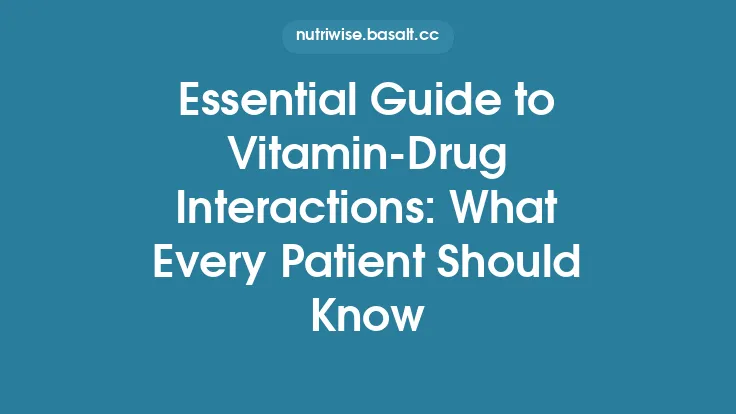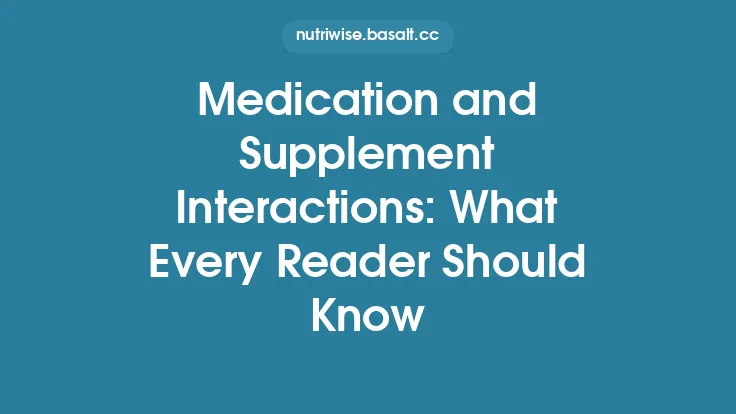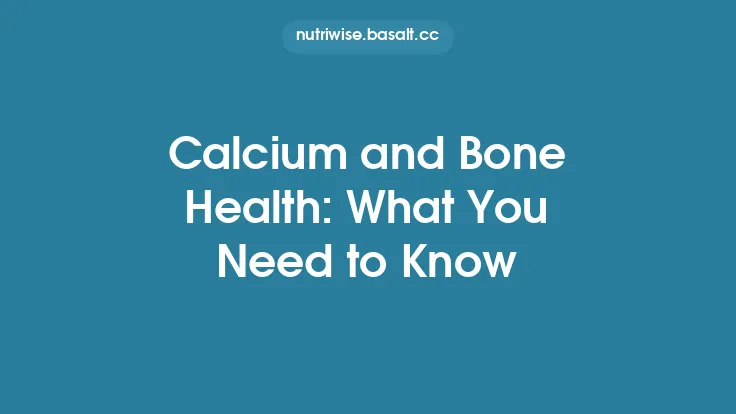Vitamin K is a fat‑soluble micronutrient that plays a pivotal role in the synthesis of several clotting factors. For individuals taking anticoagulant medications, the interplay between dietary or supplemental vitamin K and drug therapy can profoundly influence therapeutic outcomes. Understanding this relationship is essential for clinicians prescribing anticoagulants, pharmacists counseling patients, and anyone managing long‑term anticoagulation therapy.
How Anticoagulants Work: A Brief Pharmacologic Overview
Anticoagulant agents can be broadly categorized into two mechanistic groups:
- Vitamin K antagonists (VKAs) – The prototypical drug in this class is warfarin (and its analogues). VKAs inhibit the enzyme vitamin K epoxide reductase complex 1 (VKORC1), preventing the regeneration of reduced vitamin K, which is required for the γ‑carboxylation of clotting factors II, VII, IX, and X, as well as proteins C and S. The resulting reduction in functional clotting factors prolongs the prothrombin time (PT) and raises the international normalized ratio (INR).
- Direct oral anticoagulants (DOACs) – This newer class includes direct thrombin inhibitors (e.g., dabigatran) and factor Xa inhibitors (e.g., apixaban, rivaroxaban, edoxaban). DOACs bind directly to their target enzymes, bypassing the vitamin K cycle entirely. Consequently, their pharmacodynamics are largely independent of vitamin K status, though indirect interactions can still arise.
Understanding the distinct mechanisms is crucial because the magnitude and nature of vitamin K interactions differ markedly between VKAs and DOACs.
Vitamin K’s Influence on VKA Therapy
The Pharmacodynamic Link
Since VKAs directly target the vitamin K recycling pathway, any fluctuation in the amount of available reduced vitamin K can shift the anticoagulant effect. An increase in dietary or supplemental vitamin K supplies more substrate for the γ‑carboxylation of clotting factors, effectively counteracting the VKA’s inhibitory action and lowering the INR. Conversely, a sudden reduction in vitamin K intake can potentiate VKA activity, raising the INR and increasing bleeding risk.
Genetic Modifiers
Polymorphisms in the VKORC1 gene (e.g., the –1639 G>A variant) and in CYP2C9 (which metabolizes warfarin) modulate individual sensitivity to both warfarin and vitamin K intake. Patients with the VKORC1 “A” allele require lower warfarin doses and are more susceptible to INR swings caused by dietary vitamin K changes. While genetic testing is not universally performed, awareness of these variants helps explain inter‑patient variability.
Clinical Evidence
- Stability of INR with Consistent Vitamin K Intake: Multiple prospective studies have demonstrated that patients who maintain a steady level of vitamin K consumption (whether low, moderate, or high) achieve more stable INR values than those with erratic intake patterns.
- Low‑Dose Vitamin K Supplementation: Controlled trials using 90–150 µg of vitamin K₁ daily have shown a reduction in INR variability without compromising anticoagulation efficacy, particularly in patients with labile INR.
Direct Oral Anticoagulants (DOACs) and Vitamin K
Pharmacologic Independence
Because DOACs do not rely on the vitamin K cycle, their anticoagulant effect is not directly altered by changes in vitamin K intake. However, indirect interactions can still occur:
- Altered Absorption: High‑fat meals, which often contain vitamin K‑rich foods, can affect the bioavailability of certain DOACs (e.g., rivaroxaban). This is a pharmacokinetic, not a pharmacodynamic, interaction.
- Protein Binding Competition: Some vitamin K‑containing supplements may contain excipients that compete for plasma protein binding sites, modestly influencing free drug concentrations.
Clinical Guidance
Current consensus statements advise that patients on DOACs need not restrict vitamin K‑rich foods, but they should maintain consistent eating patterns around dosing times to avoid unpredictable absorption changes. For drugs with food‑dependent bioavailability (e.g., rivaroxaban requires food for optimal absorption), clinicians should counsel patients to take the medication with the same type of meal each day.
Dietary Vitamin K Variability: Clinical Implications
Sources of Variability
- Seasonal Produce Changes: Leafy greens, cruciferous vegetables, and certain oils vary in vitamin K content across seasons.
- Supplement Use: Over‑the‑counter multivitamins, fish oil blends, and herbal preparations may contain hidden vitamin K.
- Cultural Dietary Patterns: Traditional cuisines can introduce large, episodic doses of vitamin K (e.g., fermented soy products, certain cheeses).
Impact on Anticoagulation Control
Inconsistent intake can lead to:
- Sub‑Therapeutic INR → Increased risk of thromboembolic events.
- Supratherapeutic INR → Heightened bleeding risk, including intracranial hemorrhage.
For patients on VKAs, clinicians often recommend a “steady-state” approach: choose a realistic average intake level and stick to it, rather than attempting to eliminate vitamin K entirely.
Managing Vitamin K Intake for Patients on VKAs
- Baseline Assessment
- Conduct a detailed dietary history focusing on vitamin K‑rich foods and supplements.
- Identify patterns of high‑variability intake (e.g., weekend “cheat meals”).
- Education on Consistency
- Explain that the goal is *steady* intake, not necessarily low intake.
- Provide a sample weekly menu that reflects the patient’s cultural preferences while maintaining a consistent vitamin K load.
- Structured Monitoring
- Initiate more frequent INR checks (e.g., twice weekly) during periods of dietary change.
- Use home INR monitoring devices for patients capable of self‑testing, allowing rapid dose adjustments.
- Dose Adjustment Protocols
- Small INR deviations (±0.5) may be managed by temporary dose tweaks (e.g., ±5–10% of the weekly warfarin dose).
- Larger deviations (>1.0) warrant a review of recent dietary changes, medication interactions, and possible temporary cessation of vitamin K supplements.
- Consider Low‑Dose Vitamin K Supplementation
- For patients with highly labile INR despite counseling, a low, fixed dose of vitamin K₁ (e.g., 100 µg daily) can be prescribed to “smooth out” fluctuations.
Monitoring and Dose Adjustments: Practical Algorithms
| INR Change | Action for VKA Patients |
|---|---|
| < 1.5 (sub‑therapeutic) | Review recent diet; increase warfarin dose by 5–10% of weekly total; repeat INR in 2–3 days. |
| 1.5–2.0 (low therapeutic) | Maintain current dose if stable; consider minor increase if trend downward. |
| 2.0–3.0 (target range) | Continue current regimen; reinforce dietary consistency. |
| > 3.0 (supratherapeutic) | Hold warfarin dose; assess for bleeding; consider vitamin K₁ 1–2 mg oral if INR > 4.0; repeat INR in 24–48 h. |
| > 4.5 (high risk) | Hold warfarin; give vitamin K₁ 2.5–5 mg orally; consider prothrombin complex concentrate (PCC) if active bleeding. |
For DOACs, routine laboratory monitoring is not required, but clinicians should:
- Verify renal and hepatic function at least annually (or more often in high‑risk patients).
- Re‑evaluate concomitant medications that may affect DOAC metabolism (e.g., strong CYP3A4 or P‑glycoprotein inhibitors/inducers).
- Counsel patients to avoid abrupt changes in high‑fat meals that could alter drug absorption.
Special Populations and Considerations
Elderly Patients
- Reduced hepatic metabolism and polypharmacy increase susceptibility to both VKA and DOAC interactions.
- Age‑related changes in gut microbiota can modify endogenous vitamin K synthesis, subtly influencing VKA response.
Patients with Malabsorption
- Conditions such as celiac disease, Crohn’s disease, or bariatric surgery can impair vitamin K absorption, potentially enhancing VKA effect. Supplementation may be required, but must be titrated carefully.
Liver Disease
- Impaired synthesis of clotting factors already predisposes to coagulopathy. VKAs may be contraindicated; DOACs are used cautiously, with dose adjustments based on liver function tests.
Pregnancy
- Warfarin is teratogenic; low‑molecular‑weight heparin is preferred. Vitamin K supplementation is sometimes employed in the third trimester to prevent neonatal hemorrhagic disease, but this does not intersect with anticoagulation management.
Potential Drug–Nutrient Interactions Beyond Vitamin K
While vitamin K is the primary dietary factor influencing VKAs, other nutrients can indirectly affect anticoagulant therapy:
- Vitamin E: High doses may impair platelet aggregation, modestly increasing bleeding risk when combined with anticoagulants.
- Omega‑3 Fatty Acids: Possess antiplatelet properties; large supplemental doses can synergize with anticoagulants.
- Herbal Products: St. John’s wort induces CYP3A4, potentially lowering DOAC levels; ginkgo biloba and garlic have antiplatelet effects.
A comprehensive medication and supplement review should therefore include these agents, especially in patients reporting “natural” or “herbal” products.
Practical Recommendations for Healthcare Providers
- Integrate Dietary Counseling into Anticoagulation Clinics
- Use dietitians or trained nurses to obtain detailed intake histories and develop individualized plans.
- Document Vitamin K Intake in the Medical Record
- Record typical weekly servings of high‑vitamin K foods; update when dietary habits change.
- Leverage Technology
- Mobile apps that track food intake can help patients maintain consistency and provide clinicians with real‑time data.
- Standardize INR Follow‑Up Protocols
- Implement a clear algorithm for dose adjustments based on INR trends and documented dietary changes.
- Educate on Supplement Transparency
- Encourage patients to bring all over‑the‑counter products to appointments for review.
- Consider Low‑Dose Vitamin K as a Therapeutic Adjunct
- For patients with highly variable INR despite counseling, a fixed low dose can be a safe, evidence‑based strategy.
Patient Education Strategies
- Simplify the Message: “Keep your vitamin K intake about the same each week; don’t stop eating your greens, just be consistent.”
- Use Visual Aids: Portion‑size charts for leafy vegetables, cruciferous veggies, and other vitamin K sources.
- Provide a “Food Diary” Template: Include columns for day, meal, vitamin K‑rich foods, and any supplements taken.
- Highlight Red Flags: Sudden increase in leafy‑green consumption, new multivitamin, or herbal supplement should prompt a call to the clinic.
- Reinforce the Role of INR: Explain that the INR is the “traffic light” that tells whether the medication dose is right, and that diet can change the light.
Concluding Perspective
Vitamin K’s interaction with anticoagulant therapy exemplifies the delicate balance between nutrition and pharmacology. For vitamin K antagonists, the key to safe and effective anticoagulation lies not in eliminating vitamin K but in maintaining a predictable intake and responding promptly to any deviations. Direct oral anticoagulants, while largely insulated from vitamin K fluctuations, still demand attention to overall dietary patterns that may affect drug absorption.
By integrating systematic dietary assessment, patient‑centered education, and evidence‑based monitoring protocols, clinicians can minimize the risk of thrombotic or bleeding complications and ensure that anticoagulation therapy remains both safe and effective over the long term.





